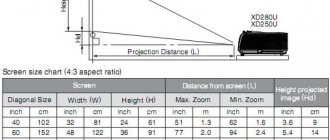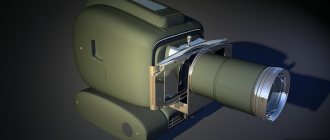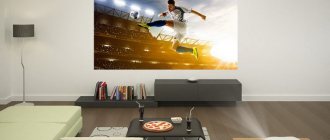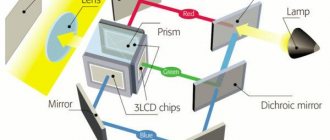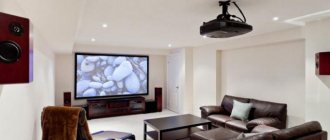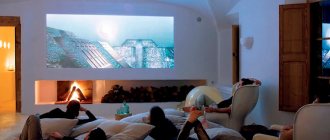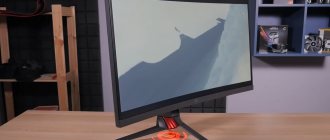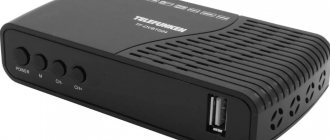Most modern offices are equipped with projectors for making various presentations, viewing photos and videos, and displaying a variety of documents. However, few of those who want to purchase projectors for the office have a good understanding of their functionality and types in order to make the right choice. In this article we will find out what this technology is, what characteristics they have and tell you how to choose a projector for the office.
What types of projectors are there?
By matrix type they are DLP, LCD, CRT, 3LCD and D-ILA type.
- DLPs are equipped with a digital matrix of microscopic mirrors. Lamp light is reflected from a microscopic chip, consisting of rotating mirrors of the smallest size and responsible for its pixel. They have excellent picture quality and are more suitable for home cinema. Disadvantages: high price, poor black color.
- LCDs are equipped with an LCD matrix through which the lamp light projects the image. Such projectors have a low price and are quite light in weight, so they are considered an ideal option for office presentations. Of the minuses: the image quality is not high enough and the black color is very poor.
- CRTs are equipped with cathode ray tubes. They have good color reproduction and rich blacks. No image graininess. Disadvantages: heavy weight, noise, inability to move the projector after fixing, difficult setup.
- 3LCDs are equipped with three LCD matrices, mirror systems that separate the image, and prism systems that collect the image. Highest color rendition, good image quality and reasonable price. Moreover, such projectors consume little energy. Of the minuses: the black color is not “black” enough.
- D-ILAs are equipped with a liquid crystal matrix that does not transmit light, but reflects it, amplifying it in a prism with the help of another lamp. Excellent clarity, color rendition and rich blacks. Of the minuses: high price.
Main characteristics
- Resolution and format. The granularity of the video image depends on the number of pixels of the liquid crystals. High resolution indicates high picture quality. High quality means high price. For office work, an expansion of 800x600 is most often sufficient, and if the budget allows, you can choose 1024x780, 1280x1024, 1600x1200 for a clearer quality of the projected image.
- Luminous flux brightness. The clarity of the picture is equal to the brightness of the light. For projectors, lamp brightness is measured in ANSI lumens (Lm). For large rooms, it is recommended to choose projectors with a brightness above 3500 lumens. For medium-sized audiences, a luminous flux in the range from 2500 to 3500 lumens is suitable. It is recommended to purchase devices with a brightness below 2000 lumens for completely darkened classrooms.
- Contrast. The ratio of the luminous flux of white and black screens is called the projector contrast. This indicator is important only if we are talking about darkened rooms.
- Zoom. Thanks to this indicator, you can reduce the image size without moving the projector.
- Lenses. Projectors with short throw lenses cannot be placed further than five meters from the screen, unlike projectors with long throw lenses.
Epson EB-X11
High quality LCD projector
Projection system: LCD | Resolution: 1024 x 768 | Brightness: 2600 lumens | Contrast: 3000:1 | Video connectors: VGA, S-Video, USB | Dimensions: 295 x 228 x 77 mm
If you're looking for a projector that can do it all, the Epson EB-X11 is a good choice. It has enough functionality to be taken seriously. Measuring 295 x 228 x 77 mm and weighing 2.3 kg, this projector is easy to move between rooms and even buildings.
You can note the presence of a lens cover that covers the lamp and speakers. The lamp here is more adaptive than other projectors, as the brightness reaches 2600 lumens.
There are also disadvantages. The picture is shown only with an aspect ratio of 4:3 . When displaying photos, this may cause black bars at the top and bottom. The resolution is not too high.
Unlike other projectors, the USB connector here can only process photos, and Wi-Fi is not supported. If all this doesn't put you off, the EB-X11 is a safe buy.
Screen selection
When choosing a screen, you first need to understand the size of the room and the location of the screen. Secondly, think about sound insulation and darkness of the room. The recommended distance between the canvas and the first row of the audience should be no less than twice the screen height, and the distance between the screen and the last row should be no less than six screen heights.
Screen fabrics are: reflective, reflective and matte.
- Reflective reflect the projected light at an angle of incidence. It is best to install such canvases under the ceiling. Thanks to this, the reflection of the image will be directed directly at the audience, which will affect the depicted material.
- Reflective sheets reflect what is being projected directly onto the light source itself, so the projector and the audience should be located opposite the screen.
- Matte canvases reflect light throughout the room, which opens up a wide range of locations for installing the device without any loss of picture quality.
Functional interface
Key features of multimedia projectors include:
- screen menu;
- remote control;
- vertical and horizontal inversion;
- adjustment of light, contrast, quality of the projected image;
- customizing the color palette;
- working with 3D material;
- control using an on-screen mouse;
- correction of keystone distortion of the projected image;
- energy saving mode of use;
- and others.
In some devices you can find the following additional functionality:
- permissibility of changing lenses;
- interchangeable lenses that can change the focus of the lens;
- use as an interactive whiteboard;
- automatic correction and adjustment of keystone distortion;
- the ability to project different colors onto the surface;
- instant disconnection of the device from the network;
- image freezing;
- the ability to repeatedly enlarge a certain area of the image;
- simultaneous display of several images from different sources;
- USB input for flash drive;
- automatic adjustment of the light flow power based on the illumination of the audience;
- and others.
Functionality
Modern multimedia projectors usually have a standard set of functionality, including:
- Availability of on-screen menu and remote control
- inversion of the image horizontally and vertically, which allows the use of translucent screens and ceiling mounting of the projector
- ability to adjust brightness, contrast, image clarity
- ability to customize color scheme
- possibility of adjustment to input signal parameters
- possibility of mechanical correction of keystone distortion of the image
- availability of an economical operating mode (reduction of luminous flux by 15-20%, ensuring an increase in lamp life by 1.5-2 times)
In addition, some projectors have additional functionality:
- freeze frame - the ability to “freeze” an image
- “electronic magnifying glass” - the ability to greatly enlarge a selected area of an image coming from a computer
- picture-in-picture function - the ability to simultaneously display images coming from two independent sources
- A/V MUTE function - dims the screen and excludes sound
- “curtain” function - opening or closing part of the image
- built-in slot for a flash card, which makes it possible to conduct presentations without a computer
- laser pointer built into the remote control
- automatic adjustment of image brightness depending on room illumination
- automatic control of the fan operating mode depending on the ambient temperature
- support for digital television standards DVT and HDTV (high definition television)
- ability to select image format (4:3, 16:9 or 16:10)
- remembering projector settings for a large number of signal sources
- the ability to replace the lens and the availability of interchangeable long-focus and short-focus lenses
- the ability to mechanically shift the lens, which is especially important when combining images from several projectors
- the presence of a network hub that provides the ability to connect the projector to a local network
- built-in software protection against theft and unauthorized use
- special function for working with interactive whiteboards
- backlit keys on the control panel
- ability to set your own screen saver
Of course, this is not a complete list and different manufacturers may have additional functions. Naturally, there is no projector that embodies all of the listed functions, so when choosing a projector you need to focus on those functions that you really need for a specific application.
Portable or mobile projectors
As you already understand, business projectors installed indoors are called stationary, however, there are also portable ones (also known as mobile or pocket). Pros of portable projectors:
- possibility of free movement;
- little weight;
- small dimensions.
Any user can connect a portable projector. It is ready to work immediately after switching on, but it also has some negative aspects:
- low brightness of luminous flux;
- poor image quality;
- limited functionality.
So, you are working in the field and, despite the listed disadvantages, you have decided to purchase a portable projector. In this case, make sure that:
- the projector you choose has a program for correcting keystone distortion and mechanical lens shift;
- has the highest brightness that such devices only have;
- has the format and resolution required for your types of presentations;
- equipped with sound speakers.
We will decide how to choose a projector for presentations among a huge number of options by reviewing the best projectors for the office of 2021. The review will cover such device manufacturers as: BenQ, Viewsonic, Acer, Epson and Sony.
Review of the best projectors
BenQ MS517H
DLP projector. Resolution - 800x600. Brightness - 3300 Lumens. Energy consumption - 270 W. Weight - 1900 g.
Possibilities:
- SmartEco Mode Adjusts light output for maximum energy savings while maintaining the best contrast-to-brightness ratio of the projected image.
- LampSave mode Allows you to reduce the frequency of lamp replacement, thereby significantly reducing the cost of servicing the device.
- EcoBlank mode If the projector is not used for three minutes, it automatically switches to a mode that allows you to save energy.
- 3D format support.
ViewSonic PJD5151
DLP projector. Resolution - 800x600. Brightness - 3300 Lumens. Energy consumption - 260 W. Weight - 2200 g.
Possibilities:
- SuperColor Technology A special technology that provides the highest color reproduction over a wide range of colors.
- Smart Restart function If the projector is not used for three minutes, it automatically enters standby mode.
- Mouse Button This button allows you to control the projector in the style of a computer mouse.
- Lamp door on top Facilitates the process of replacing lamps and servicing the device.
- Templates built into the projector.
- 3D format support.
Acer X113
DLP projector. Resolution - 800x600. Brightness - 2800 lm. Energy consumption - 235 W. Weight - 2500 g.
Possibilities:
- Acer Color Technology Guarantees bright and clear images of text and pictures even from a long distance.
- Acer Dust Shield does not allow dust to accumulate, so the brightness of the projected image is not lost, but the need to frequently service the device is lost.
- Has 4 ceiling mounting options.
- Switch to economical standby mode.
- 3D format support.
Epson EB-S31
3LCD projector. Resolution - 800x600. Brightness - 3200 lm. Energy consumption - 200 W. Weight - 2400 g.
Possibilities:
- A universal projector suitable for both home and office.
- Rich colors even in daylight.
- Possibility of broadcasting material simultaneously from different sources.
- Body Slider A slider located on the body allows you to quickly correct keystone distortion of the projected image.
- Economy mode If there is no signal for 5 minutes, it automatically enters sleep mode, in which energy consumption is reduced by 70%.
Related questions
How many lumens do you need to project in daylight? Different rooms have different levels of light. If you've set up a dedicated home theater room with little or no ambient lighting, a projector with 1000 ANSI lumens will do the trick. (Higher ANSI lumens will work.) However, for rooms with limited natural light, a minimum of 1,500 ANSI lumens is better. In rooms with a lot of ambient air, such as a living room with large windows, you should choose projectors with a brightness of at least 3,000 ANSI lumens.
What is a good projector resolution? The best resolution for you depends largely on the size of your screen. Ideally, the higher the resolution, the sharper the image will be. For screens 130 inches or larger, it's best to invest in a 4K projector. However, at a minimum, you shouldn't invest in a projector with a resolution less than 1080p. Additionally, poor input quality will result in an equally poor projected image. I mentioned above that Blu-ray players, game consoles, and the Amazon Fire TV Stick all use HDMI connections. HDMI is generally considered a 1080p signal, meaning your projector's resolution should be at least equivalent to that.
What does WXGA mean on a projector? Extended Graphics Array (XGA) is the minimum resolution offered by modern projectors. (XGA resolutions are those listed as 1024 x 768 and considered to have a 4:3 aspect ratio.) However, wide XGA (WXGA) has replaced this resolution as the base specification for both TVs and projectors. WXGA resolution means your projector produces images up to 1280 x 800 pixels. WXGA is not exactly HD resolution, although many modern lower-end projectors have this number of pixels.
